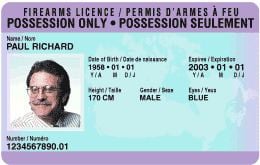 | ||
Firearm Licensing Overview
All of the following require a licence in Canada
Contents
- Firearm Licensing Overview
- Possession and Acquisition Licence PAL
- Other Firearms Licences
- ObtainingApplying for a PAL
- Classification of firearms
- History
- Transportation of firearms
- References
Non-residents may wish to note "A Non-resident firearms declaration that has been confirmed by a customs officer is deemed to be a temporary licence for up to 60 days". [For that firearm. It is effectively a POL, not a PAL - see below]. (A " Non-resident firearms declaration" is a specific form that should be reviewed in advance of travel, not an oral statement at the border).
Possession and Acquisition Licence (PAL)
The Possession and Acquisition Licence (PAL) is the primary licence for possession of a firearm and acquisition of ammunition, and it is both required and the only permissible document for an individual to acquire or permanently import a firearm. Applicants must be 18 years of age. There is no requirement of citizenship or residency (although different forms, and slightly different requirements apply)
Other Firearms Licences
Other firearm licences for individuals include:
NOTE: While issued licences read either "Possession • Acquisition" or "Possession Only", the Firearms Act and regulations refer to either "Possession and Acquisition Licence" or "Possession Licence" - without the word "Only".
Obtaining/Applying for a PAL
All licensing of firearms in Canada is managed by the RCMP's Canadian Firearms Program (CFP). In the Canadian system, there are three classes of firearms and firearm licences: non-restricted, restricted and prohibited. See Classification of Firearms below for complete details on prohibited, restricted and non-restricted firearms.
A Possession and Acquisition Licence is a licence that allows individuals in Canada to possess and acquire firearms as well as ammunition. Licences are typically valid for five (5) years and must be renewed prior to expiry to maintain all classes. Once licensed, an individual can apply for a firearm transfer; and an Authorization To Transport (ATT) for restricted and prohibited firearms. If an individual possessing a PAL is convicted of certain offences, a PAL can be revoked. If an individual does not renew their PAL prior to its expiration date or if they have their PAL revoked, they must legally dispose of any firearms in their possession. A licence for prohibited firearms can be issued to qualifying businesses, and very rarely to individuals (firearms they own, as the gun laws changed over time.) Previous convictions for serious violent, drug or weapons offences almost invariably result in the denial of the application.
A PAL is generally obtained in the following three steps:
Licences are typically valid for five (5) years and must be renewed prior to expiry to maintain all classes. Once licensed, an individual can apply for a firearm transfer; and an Authorization To Transport (ATT) for restricted firearms.
Classification of firearms
Like licences, firearms are classified into prohibited, restricted and non-restricted categories, as defined by Part III of Criminal Code (R.S., 1985, c. C-46)
Prohibited firearms include:
Restricted firearms are:
Non-restricted firearms are:
History
PALs were introduced in Canada in 1995 as part of Bill C-68 as a replacement for the FAC (Firearms Acquisition Certificate) system. Whereas the FAC was only required to acquire a firearm, a PAL is required to both acquire and possess firearms and to acquire ammunition. A PAL for non-restricted firearms allows its holders to acquire and possess any non-restricted firearm, while a PAL for restricted firearms (which also covers prohibited firearms to those eligible) allows the holder to acquire and possess restricted firearms.
When first implemented, the PAL also allowed the holder to acquire a cross-bow, although no licence was required to possess one. There is no longer a licensing requirement for purchasing cross-bows.
Transportation of firearms
The transportation regulations are broken down into two divisions: those for non-restricted firearms and those for restricted or prohibited firearms. These rules are laid out in the Storage, Display, Transportation and Handling of Firearms by Individuals Regulations. A non restricted firearm may be transported so long as it is unloaded. Such a firearm does not need to be encased or trigger locked.
A restricted firearm must be disabled by use of a trigger, cable, or other locking device and locked in an opaque case. An unattended non-restricted firearm left in a vehicle must be locked in the trunk or other compartment, if one is available. In order to transport restricted or prohibited firearms, an individual must obtain an Authorization to Transport. An ATT is generally approved only for individuals to transport a restricted or prohibited firearm to a shooting range for target practice, gun show for sale, to a gunsmith or gun shop or for a competition (e.g.: IPSC).
An Authorization to Carry (ATC) allows a person to carry a restricted firearm or prohibited handgun concealed (if specified as a condition of carry) and loaded. An ATC for open carry is usually only issued to employees of armoured car companies or for other limited employment reasons. In very rare situations, an ATC may be issued for protection of life, which would allow the holder to have a loaded handgun with them, or at home, without violating safe storage rules that usually require an unloaded firearm to be trigger locked and secured.
